Museum History
The following section aims to tell the story of the development of the Herring Era Museum.
We trace the unusual origins of the museum planning committee - how a grassroots organization founded in 1989 led to the formation of an internationally recognized Museum, housing one of the largest collections in Iceland. The information presented is based on the administrative records of the Municipality of Siglufjörður, as well as from my personal first hand experience and knowledge of these issues since 1978.
- Örlygur Kristfinnsson, January 2013.
The Roots of the Herring Museum of Iceland can be traced to the year 1957
At a Town Council meeting in Siglufjörður on 13 March, 1957 five new members were elected with the goal of creating a Heritage Museum. The following members were elected to the Board: Guðbrandur Magnússon, teacher; Hlöðver Sigurðsson, principal: Jón Kjartansson, mayor; Pétur Björnsson, trader; and Sigurður Gunnlaugsson, town secretary and elected Chairman. At this same meeting, it was agreed to submit to the Board a specific location and a budget of 20,000 ISK to establish the museum.
In July of the same year Ragnar Ásgeirsson, a consultant from Reykjavík, met with the Board. He recommended that they focus on items and artifacts connected to the fisheries. Around this same time, the collection was begun.
During the years 1957 to 1965, the Board held a total of nine meetings before a hiatus of eight years in planning. Relatively little is preserved from this first planning phase of the committee: one registration form was found from 1972 which lists 28 objects that were found and preserved in storage at three locations. Some of the objects found were considered to have little historical value - for example "elliptical shaped box [probably from the 19th century], without base, moldy, useless and disgusting."
The collection of these objects was undertaken by the five member Board and registered by Guðbrandur Magnússon on 22 March 1972.
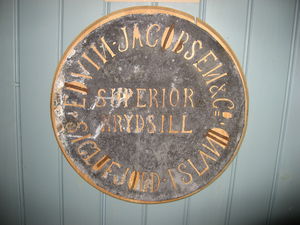 One of the items from the first years of collecting - from Edwin Jacobsen's salting station.
One of the items from the first years of collecting - from Edwin Jacobsen's salting station.
1977: A new chapter
The council of Siglufjörður hired Frosti Jóhannsson to explore the possibility of launching the new Museum, and to continue building the collection. Frosti, who was studying to be a folklorist in Sweden, worked diligently to address these issues over the course of three years.
At this stage (1978 - 1980), the Museum Board included Anton Jóhannsson, Guðbrandur Magnússon, Konráð Baldvinsson, Sigurjón Sigtryggsson and Örlygur Kristfinnsson.
At a meeting on 18 July, 1977 the Board approved the following plans: Preserve three historical buildings, to purchase the old salting station Róaldsbrakki, to provide an office and warehouse space, preserve two Purse-seine boats, to hire Frosti F. Jóhannsson as Project Manager and to document the remaining structures from the herring years.
Collecting began that same summer with a primary focus on 'herring monuments', tools, boats and fishing gear. Three houses designated to serve as the Museum were preserved. The old Norwegian Sailors home (1915) was to host the Heritage Museum; Róaldsbrakki (1907), the herring history; and Sæbyshús (1886) preserved as a typical Icelandic home.
Frosti laid out ambitious plans for the Herring Museum. A part of his proposal was that it would be one department in a large Maritime Museum of North Iceland, located in Siglufjörður. Frosti spent his last summer here initiating research on the employment history of Siglufjörður and to identify the lots that once held varied corporate giants.
When it became clear that the controversial plans for a Heritage Museum in Siglufjörður would not be accomplished without much detailed historical research and also that renovations to the buildings would require significant funding, the interest from the local community waned. Frosti Jóhannsson resigned in 1980.
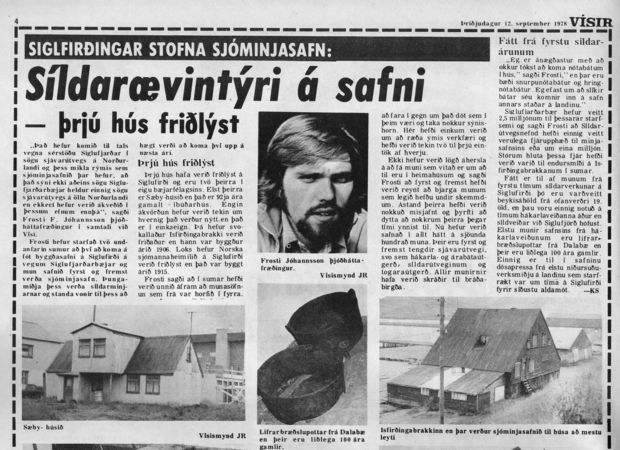 Plans for museum construction gained wide attention.
Plans for museum construction gained wide attention.
Beginning in 1989
The foundation which Frosti Jóhannsson and the progressive Siglufjörður Town Council had established, remained but little happened over the next decade. Enthusiasts from "out of town" were anticipating the next steps in the development of the Museum's sites and plans.
Little was heard from the City Hall between 1985 and 1989 - other than a suggestion to demolish Róaldsbrakki (one of the historical houses!), to shelve the Museum Board and to bury the collective dream of the museum. In the summer of 1985, a group of enthusiasts undertook the renovations of Róaldsbrakki, painting the walls and exterior of the house.
On September 23, 1989, a considerable number of residents came forward and formed a non profit partnership, called FÁUM, for the primary purpose of building a museum. The board were elected: Örlygur Kristfinnsson, Kristrún Halldórsdóttir, Anton Jóhannsson, Hinrik Aðalsteinsson and Regína Guðlaugsdóttir. Substitutes: Birgir Steindórsson, Bragi Magnússon and Guðný Róbertsdóttir. In October, an agreement to take possession of the designated buildings was signed with the Town Council of Siglufjörður. FÁUM now owned Róaldsbrakki, where most collectibles, including three boats, were stored.
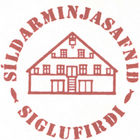
Below is the structure of the process described in a logbook
Year 1990:
FÁUM-partners work on new foundations for Róaldsbrakki. The bottom floor of the house is demolished and moved about 40 meters to a new base. Jón and Erling Co. construct this new foundation. All collectibles are stored and displayed in the temporary museum location of Hafnarhæð. Volunteers show interest in preserving Bein, a former bone-meal factory.
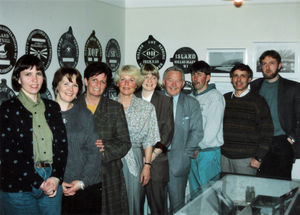
FÁUM - volunteers
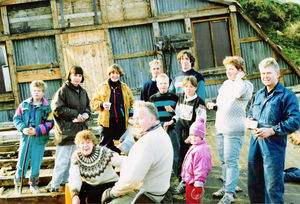
Year 1991:
On the 20 May, the birthday of Siglufjörður, FÁUM open an exhibition in the temporary museum location of Hafnarhæð. A larger than expected crowd attend the opening, and Thor Magnússon, Director of the National Museum of Iceland gives a speech. This same day, Örlygur Kristfinnsson, later Museum Director, speaks on television about the main goals of the Museum committee: rebuilding Róaldsbrakki with a deck in front, where salting demonstrations could take place.
The new Róaldsbrakki is blown from its foundation and substantially damaged during an August wind storm. Later that same winter, Bein is also blown from its foundations – after many volunteers have contributed significant time renovating both buildings. An overview of the Herring Museum is published and widely distributed. The first 'Herring Adventure' festival is held in Siglurfjörður - this same event continues to this day.
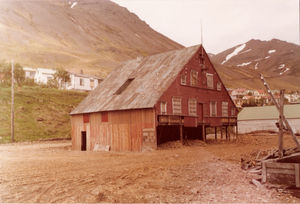 Róaldsbrakki at it's worst in 1984
Róaldsbrakki at it's worst in 1984
 Looking towards the future - drawn in 1991
Looking towards the future - drawn in 1991
Year 1992:
Reconstruction of Róaldsbrakki continues with support from the Cultural Heritage Agency of Iceland and various donors.
Volunteers work themselves to the "bone" to rip apart the ruins of Bein. Large timbers are salvaged for repairs and new construction. The exhibition at Hafnarhæð is open daily during the summer attracting about 1,700 visitors.
Year 1993:
Repairs continue on Róaldsbrakki. Volunteers travel to Ingólfsfjörður and collect machinery from the old herring factory. Extraordinary efforts are made to retrieve valuable artifacts. Five men spend the summer cleaning the machinery and other museum objects.
Year 1994:
On July 9th, an official opening ceremony for Róaldsbrakki is held. The first direct financial contributions from the town council of Siglufjörður to accelerate the development of the museum are received. The museum opens with a beautiful exterior renovation and a historical exhibition on the ground floor, along with a new front deck where salting of herring is demonstrated, accompanied by accordion playing. Ólafur G. Einarsson, Minister of Education, officially inaugurates the museum and Thor Magnússon, Director of the National Museum of Iceland gives a speech.
In tandem, a small temporary exhibition in the old engine house beside Róaldsbrakki opens. Many visitors are in attendance at the opening festival. FÁUM buys Njarðarskemma, a building north of Róaldsbrakki. Volunteers collect artifacts from the old herring factory in Hjalteyri. Registered visitors to the museum this summer number 4,250.
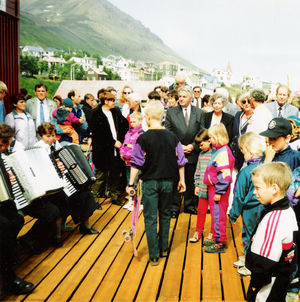 Róaldsbrakki inaugurated on 9 July 1994.
Róaldsbrakki inaugurated on 9 July 1994.
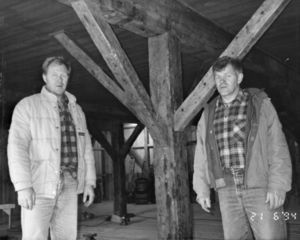 Ágúst and Hjálmar - renovating Róaldsbrakki
Ágúst and Hjálmar - renovating Róaldsbrakki
Year 1995:
Ongoing repairs to Róaldsbrakki are the focus of this year - with the restoration and exhibition design work on the second floor as the primary goals. This summer regular exhibitions of salting take place: tourists are shown the old practices and daily life of the herring years in a lively and entertaining way. Salting exhibitions continue to be an integral part of the work of the museum and attract a lot of attention and enjoyment.
Year 1996:
Reconstruction of Róaldsbrakki is complete. A large number of volunteers spent time repainting the building etc. Róaldsbrakki is complete for use as museum building (exhibitions on all three floors). Örlygur Kristfinnsson hired full time as Director. Hafþór Rósmundsson becomes Chairman, and the following people are appointed to the Board: Anton Jóhannsson, Birgir Steindórsson, Guðný Johansen, Hinrik Aðalsteinsson, Regína Guðlaugsdóttir, Sigurður Guðmunðsson, Sveinn Björnsson, Sturlaugur Kristjánsson and Thor Jóhannsson.
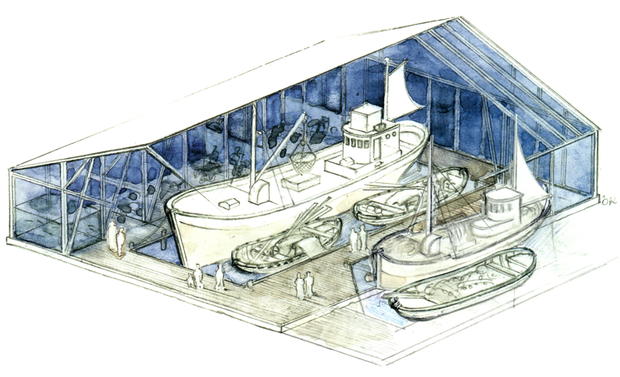 Planning the Boathouse exhibition 1996 - 1997. Drawn by Örlygur Kristfinnsson, Museum Director.
Planning the Boathouse exhibition 1996 - 1997. Drawn by Örlygur Kristfinnsson, Museum Director.
Year 1997:
A small publication is produced to provide an overview on proposed future development of the museum. It describes in words and pictures how a new building could house an exhibition of historic boats and fishing gear. The Director works on these plans for many months with the support of the Board. At a meeting with the Minister of Education, Björn Bjarnason, he announces his decision to contribute 10 million ISK to the further development of the museum. The Museum Director spends the autumn constructing drawings for the herring factory exhibition. FÁUM buys Andrésarhús.
Year 1998:
Carpenters work on the foundations for Grána, the herring factory. During a Town Council meeting on Siglufjörður‘s birthday, May 20th, the municipality donates 10 million ISK to the development of the Herring Era Museum. The Museum's first website opens. Volunteers travel to Ingólfsfjörður to retrieve more objects from the former herring factory. The Herring Era Museum receives the first award every presented by the Icelandic Innovation Tourist Board.
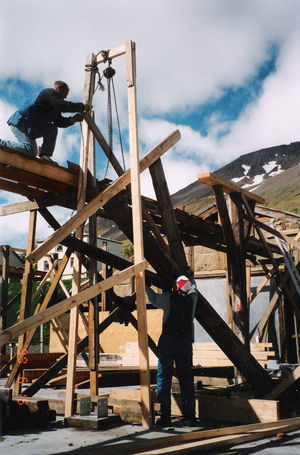 Ágúst og Hjálmar building Grána, 1999
Ágúst og Hjálmar building Grána, 1999
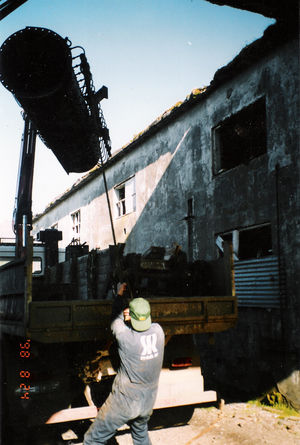 Hoisting the cooker in Ingólfsfjörður
Hoisting the cooker in Ingólfsfjörður
Year 1999:
Grána is built – wood salvaged from Bein is put to good use. Another trip to the old factory in Hjalteyri. On their 60th anniversary meeting, the Federation of Icelandic Fishing Vessel Owners, approves a 5 million ISK donation towards the construction of the third museum building, the Boathouse. Engineer Þorsteinn Jóhannsson evaluates the most suitable location of the building.
Two cruise ships arrive in Siglufjörður for the first time – to pay a special visit to the Herring Museum.
At a meeting in the Parliament on June 17, the Museum is awarded honorary recognition by the Republic Museum Foundation.
Year 2000:
Construction of Grána is complete and folk music concerts held within it for the first time, along with a photo exhibition in the loft. Sigurjón Jóhannsson, stage designer is asked to provide a working model for the Boathouse exhibition. New exhibition proposals, based on earlier drawings by the Museum Director, are approved by the Board.
The Museum is awarded the first Icelandic Museum Award.
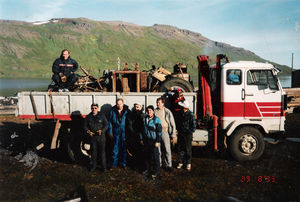 Volunteers in Ingólfsfjörður in 1993
Volunteers in Ingólfsfjörður in 1993
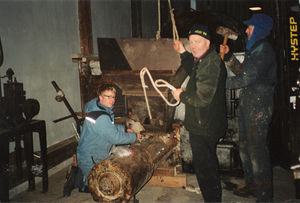 Chris Bogan, Gunnar Júl. and Örlygur in Grána
Chris Bogan, Gunnar Júl. and Örlygur in Grána
Year 2001:
Boathouse planning continues. Árni Páll Jóhannsson, a stage designer, provides consultation on the building's appearance. He presents drawings of a three segment building in line with the appearance of the existing museum buildings. Foundations are laid. Work begins on the installation in Grána. Chris Bogan, a Canadian historian, collaborates with the Museum Director. Additionally, five men are hired temporarily for the work on Grána.
Year 2002:
Preparation of the Boathouse continues. The ship Týr SK 33 is brought from Sauðárkrókur and placed alongside Draupnir EA 70 inside the base of the new, still unbuilt, Boathouse. Installation of the Grána exhibition continues.
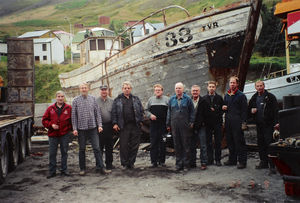 After transferring Týr SK from Sauðárkrókur, 2002
After transferring Týr SK from Sauðárkrókur, 2002
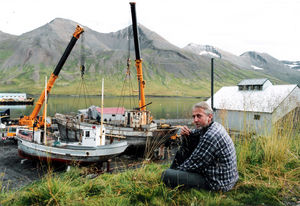 The boats in it's final port
The boats in it's final port
Year 2003:
Boathouse construction begins in the middle of summer. The roof is complete by the end of the year. The factory exhibition in Grána is finished. The Icelandic Museum Council recommends the Herring Era Museum as Iceland's entry for the European Museum Award - the first Icelandic participant in the 25 year history of this competition. Wim van der Weiden, Chairman of the European Museum Forum visits and assesses the museum.
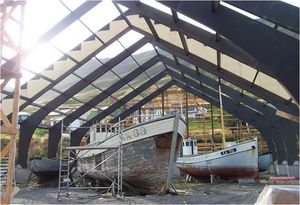 Building the Boathouse in 2003
Building the Boathouse in 2003
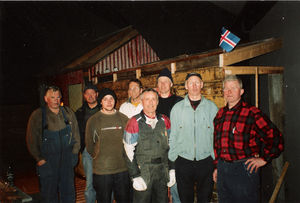 Our carpenters
Our carpenters
Year 2004:
The Boathouse is complete and is inaugurated on June 29 by Haakon Magnus, Crown Prince of Norway. A large festival is held in July to commemorate the 100 year history of Icelandic herring industry. The Herring Era Museum is awarded 'Best New Industrial Museum' in Europe by the European Museum Forum. The Museum Director attends the conference ceremony in Athens in May.
Year 2005:
15 years of restoration and construction work for the Herring Era Museum are completed. The old Róaldsbrakki has become an elegant building, two large museum buildings constructed and a large collection of "old, ruined stuff" has been turned into a treasure – in what is now the third largest museum in the country.
An agreement is signed in August with Þorgerður Katrín Gunnarsdóttir, Minister of Education, for a payment of 40 million ISK to help with the costs of construction work over the years. This allows for coverage of initial expenditures on these large projects.
Foreign dignitaries, including Nordic ministers, visit the Museum. Museum buildings are used for various notable concerts and exhibitions, confirming the new position of the Herring Era Museum in the public eye.

Year 2006:
A private foundation is established with the new name: The Herring Era Museum of Iceland. This marks the end of FÁUM (volunteers) running the museum –now that it has become a larger institution. Repairs to the boats in the Boathouse begin.
Year 2007:
Repair work on boats continues. The museum buildings are in use for a wide variety of cultural events including the Folk Music Festival and art exhibitions.
The Midsummer Night's festival is held to commemorate the 100th anniversary of Róaldsbrakki – a conference about Halldór Laxness Guðsgjafarþula. Ten employees are now on the payroll but only the position of Director at the museum is permanent.
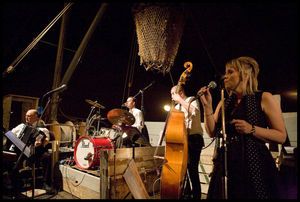 From the museum's Midsummer Night's festival
From the museum's Midsummer Night's festival
Year 2008:
Midsummer Night's festival is held at the Museum for a second time, including a conference and an evening concert - this last in the spirit of an old radio program in which fishermen could call in and request their favorite songs. In August a formal collaboration is established with the Wooden Boatbuilding Conservation Centre in Gratangen, Northern Norway. Two men from the Museum travel to Norway and assist with rowboat construction for three weeks.
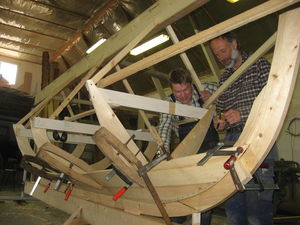 Skúli Thoroddsen and Björn Lillevoll building Soffía at the Old Slipway
Skúli Thoroddsen and Björn Lillevoll building Soffía at the Old Slipway
Year 2009:
Two new employees are hired: Rósa M. Húnadóttir, folklorist and Skúli Thoroddsen, carpenter. Follow-up projects are undertaken under the supervision of Björn Lillevoll from Gratangen center for conservation of wooden boats.
Year 2010:
A groundbreaking agreement is made with the Ministry of Education which provides a new role for the Museum and establishes annual contributions from the state. A department is set up within the museum to help locals establish a Ski Museum, with the aim of collecting objects, documentation of history and an exhibition about skiing – given Siglufjörður's rich history of skiing and professional skiers. Repairs to Týr SK, the largest boat in the Boat House, are complete. Now on display, the boat itself is open and accessible to visitors. Anna Snorradóttir donates the former residence of her parents, Hlíðarhús, which dates back to 1898, to the Museum.
Year 2011:
With improved transportation via the Héðinsfjörður tunnel, attendance to the museum increases exponentially: from 11,800 to 19,300 visitors - an increase of 60%. Historian Anita Elefsen is appointed Curator of the Museum. Carpenter Skúli Thoroddsen retires. Museum staff work on the systematic research of herring history, culture, and the registration of objects and artifacts into a historical database for Icelandic museums. On behalf of the museum, the book Story from a Herring Fjord is published and illustrated with watercolors by the Museum Director. Through it, we intend to educate young people about the herring era.

Year 2012:
In March, the municipality of Fjallabyggð hands over the old Slipway to the Museum. The Museum has long desired to preserve this building, one of the oldest small boat building workshops in the country. An exhibition of 200 years history of wooden boat building and repair in Siglurfjörður is designed and opens in the Old Slipway.
An exhibition covering the 100-year history of fish-meal and fish-oil industry in the country opens on Midsummer Night. Museum staff creates a fascinating exhibition of 15 displays for Grána, intended as a traveling exhibit throughout the country in the coming years. A seminar on the history and status of the fish-meal and fish-oil industry today is held.
Considerable development takes place in the Museum area where walking piers are built in between all three museum buildings.
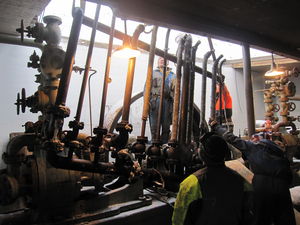
Year 2013:
Boatbuilder Jón Ragnar Daðason is hired. Among his projects are ongoing construction of the walking piers in the museum area. When the walking piers are complete, appropriate lighting is installed. Jón Ragnar also spends much time in the Old Slipway to repair an old boat. Preparations begin for a new museum building, the Salt House, which will rise between Grána and Róaldsbrakki.
A Salting Demonstration is requested by the Coast Cultural Festival in Karlskrona, Sweden. A group of ten 'herring girls', workers and an accordion player travel to Sweden to represent the Museum and participate in the Festival.
The seventh Midsummer Night Festival is held at the Herring Era Museum and is very successful. Attendance at the museum reaches a record high of 19,845 visitors, with as many as 46% of attendees coming from foreign countries.
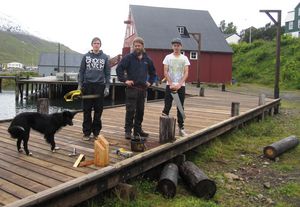
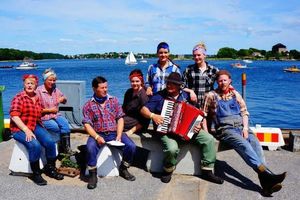 The "Herring-crew" at the Coastculture festival in Karlskrona
The "Herring-crew" at the Coastculture festival in Karlskrona
Year 2014
Steinunn M. Sveinsdóttir hired early this year. The biggest project of the year was moving the Salthouse, a 18th century warehouse, from Akureyri and rebuilding it on the museum grounds.
Njarðarskemma reconstructed and installation of a new exhibition on electricity production for the benefit of the herring industry began.
In September 25 years had passed since FÁUM was formed, 20 years since Róaldsbrakki was inaugurated as a Museum building, 15 years since Grána was built and 10 years since the Boathouse. This big anniversary was celebrated with numerous supporters and benefactors of the Museum.
Year 2015
Over 22,000 museum visitors this year - and for the first time foreign visitors were in the majority, counting 52%. Nineteen cruise ships visited Siglufjörður and The Herring Era Museum.
The Museum participated in a Nordic Coast Culture Festival in Mariehamn, Åland Islands. Work continued on the development of The Salthouse.
A new exhibition was opened in Njarðarskemma in June - "electricity and the herring industry" where electricity production for the benefit of the herring industry is discussed. The opening of the exhibition was the Herring Museum's contribution to the Cultural Heritage Days of Europe 2015.
Year 2016
Örlygur Kristfinnsson retired as museum director in April and Anita Elefsen took over the position. Once again previous visitor records were broken, with a total of 25,000 visitors and 58% international visitors.A large oil tank had reached the stage of demolition but was considered such a high-quality construction and has such a unique history that it was decided to preserve it at the Herring Era Musem. During WW2 it was painted as a residential building to mislead German enemy planes. The tank now stands between Grána and The Boathouse.
The Siglufjörður Photo Archive was gifted to the Museum on May 20th. The archive was for a long time one of the largest private collections in the country and counts over a hundred thousand photographs.
A week-long boat building course was held at The Old Slipway, under the guidance of boat builder Hafliði Aðalsteinsson.
Year 2017
In September, the annual three-day professional conference for Icelandic Museum professionals took place on Siglufjörður. Museum director Anita Elefsen performed the role of conference director. The theme of the conferece was "Museums in the digital world" with around 150 participants.In October, the Herring Era Museum received the Icelandic Tourism Board’s Environmental Award for beautifying the environment and improving accessibility for museum visitors.
Collaboration and work exchange was organized with the Maritime Museum in Gdansk, Poland. Two employees of the Herring Museum went on a week-long educational trip to Poland and visited four branches of the Polish museum. Later in the year, four employees from the Maritime Museum in Gdansk visited Siglufjörður and the Herring Museum.
Year 2018
Once again visitor numbers reached a new high with over 27,500 museum guests. The number of international visitors increased to 73%. Cruise ship arrivals increased by half, from twenty-two to forty!The Herring Museum contributed a lot to the preparation and implementation of the Nordic Coast Culture Festival, which took place on Siglufjörður in July. In Grána, a seminar on clinker-boats was held. Norwegian and Icelandic boat builders were at work in The Old Slipway, and a boat building course was held. A large herring buffet was set up, where Swedish chefs prepared delicious herring, both marinated and grilled. A new outdoor exhibition was opened, about Sweden's herring fisheries off the coast of Iceland. The exhibition was done in collaboration with Bohuslän Museum in Uddevalla, Sweden.
Cooperation with Gamvik Museum, in North Norway. A joint research on comparing the communities of the two museums in the past and the present - and setting up an exhibition.
In December, the museum published a book; Siglufjörður. Photographs 1872-2018. The authors of the book are the museum staff, Anita Elefsen, Steinunn M. Sveinsdóttir and Örlygur Kristfinnsson. The occasion for the publication was Siglufjörður's 100-year anniversary on May 20. 2018. The book was the museum's contribution to the community at this important turning point and at the same time a step towards sharing the local history.
Year 2019
A survey conducted among tourists who visited museums and exhibitions in North Iceland in the summer of 2019 showed that 98.7% of the respondents said they were very happy or satisfied with their visit to the Herring Era Museum - and none of the respondents were dissatisfied!Steinunn M. Sveinsdóttir left her position and Inga Þórunn Waage was hired. The Herring Museum joined ICMM, the International Congress of Maritime Museums. In cooperation with the Department of Museum Studies at the University of Iceland, an intern was hired for nine weeks.
An extensive research project was undertaken during the year, as the museum director traveled around the country with a cameraman, to interview both men and women who worked in herring industry, whether on land or at sea. There were seventy interviewees – all across the country.
Year 2020
The COVID-19 pandemic took a heavy toll on the museum's operations. It turned out to be necessary to reduce the number of employees and either postpone projects or simply write them off.The number of museum visitors decreased by 55% from the previous year and was around 12,000 - of which foreign visitors accounted for around 27%.
A collaborative project with the Gamvik Museum in Northern Norway was completed. A new outdoor exhibition was opened, where the results of the project are shared.
In August The Herring Era Museum began to regularly teach local elementary school children. Students in the 5th grade attended the museum every Monday, as well as a mixed group of students from the older classes.
Year 2021
The number of museum visitors increased by 73% and totalled around 20,000. Gathering restrictions, due to COVID-19, continued to affect the museum's operations for most of the year.Work continued on the schoool project, in collaboration with the local Elementary School. The project was extremely successful and was nominated for the Icelandic Museum Award in the spring of 2022.
Year 2022
Over 30,000 people visited the museum – more than ever before, with 70% international visitors.Daníel Pétur Daníelsson was hired. The number of year-around staff increased from 2.5 to 4 during the year.
Two employees of the Herring Museum attended workshops in the Czech Republic, and likewise a group from the Czech Republic came on a field trip to Siglufjörður in late summer – both part of a European project consisting of the restoration of original equipment and the installation, design and opening of a brewery museum and archive in Kostelec nad Černýmilesy in the Czech Republic.
In November, heavy rain resulted in the wells overflowing and the drainage pipes in the museum area to block. Water flooded up through the floor at Njarðarskemma, so the water level inside the house was just under 80 cm. A lot of rescue work was done; to pump the water out and dry the house. Later, assess damage to artefacts, map the exhibition and catalog it, pack artefacts and museum items and move to storage.
In December the museum's staff put on a Christmas concert in the Boathouse, and all income from the concert went to local Christmas aid for Icelandic families in need.
The construction of the Salthouse moved forward very well this year. The building will greatly improve the conditions for the preservation of museum collection and other professional work with improved facilities for staff. This milestone was celebrated with the first gathering in the building; a Christmas dinner for the museum's staff, board and main benefactors.
